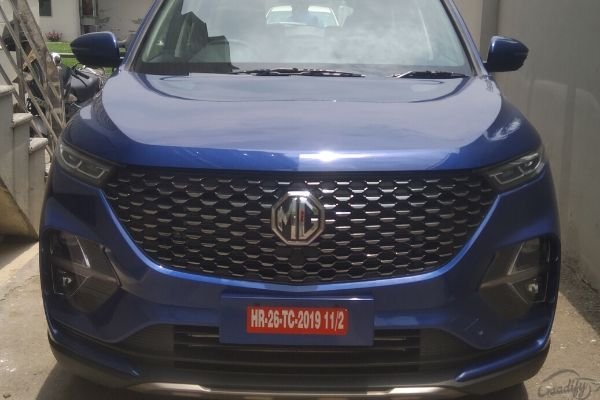With the introduction of BS6 emission norms, Maruti Suzuki has made some drastic changes in its portfolio, the most prominent being the discontinuation of its popular diesel engine. That is, all cars of Maruti are now available only with petrol engines and some with the CNG option as well. In this series, cars like S-Cross and Vitara Brezza, which used to come with only diesel engines, have also been introduced with petrol engines. Maruti had goodbye to the fiat-sourced 1.3-litre diesel mill and replaced it with a tried and tested 1.5-litre petrol engine that also powers the Ciaz, Ertiga, and XL.
So, has the new petrol engine made a difference in the pricing and driving capabilities of the S-Cross? Let's find out, but before that have a look at its design, features, and other important aspects as well:-

Exterior
With the BS6 upgrade, Maruti hasn't made any changes to the exterior and interior. However, the crossover design appeal of S-Cross still looks fresh and good. Its thickset chrome grille at the front and black applique on the lower profile is the main and most loved highlight of this cross-hatch. It continuous to get LED projector headlamps with integrated LED daytime running lamps (DRLs), 16'' machine cut alloy wheels and LED rear combination lamps, silver skid plates on both bumpers and silver-finished roofrails in top-spec Alpha variant. Overall, the design of Maruti S-Cross is sophisticated and is something that will be cherished by people of all ages. Here, have a look at its dimensions:-
| Length | 4300mm |
| Width | 1785mm |
| Height (with roofrails) | 1595mm |
| Wheelbase | 2600mm |
| Ground Clearance | 180mm |
| Boot space |
seatback raised at position 1:- 353L seatback raised at position 2:-375L |
| Fuel tank capacity | 48 |
Interior & Features

The interior layout of Maruti S-Cross petrol is the same as before. For a change, it gets an updated 7.0-inch Smartplay Studio touchscreen infotainment which also supports cloud connectivity. It also gets Android Auto and Apple Carplay connectivity. The second change is an automatic shifter in the centre console, obviously, in the case of automatic variant only.

Apart from this, it gets the same set of equipment as the previous model which includes automatic climate control, auto-dimming IRVM, cruise control, rain-sensing wipers, the engine starts/stop button, keyless entry, semi-digital instrument cluster with monochromic MID (multi-information display), steering mounted switches for audio, telephony and cruise control, tilt and telescopic adjustable steering, electrically adjustable ORVM, manually height-adjustable driver seat, front and rear armrest, sunglass holder, vanity mirror on both sunshades with illumination, electromagnetic boot release, height-adjustable front seat belts etc.
Space, Quality and Comfort
The interior design of Maruti S-Cross is very conventional and subtle, yet feels premium. It houses an all-black theme, but despite this, its cabin feels spacious and airy all thanks to its wide windows and quarter glass panels. The material quality is not top-notch. It comprises hard plastic. Only the top part of the dash having soft plastic.
The front seats of S-Cross are quite comfortable. Apart from conventional reclining and sliding function, the driver seat also comes equipped with height-adjustable function. But despite being the most premium car of Maruti Suzuki, you have to get in the desired seating position by your own though the mechanical means which is very disappointing. However, it offers both telescopic and tilts adjustment function for the steering wheel, which is advantageous to get you in your most comfortable position. You also get an armrest at the end of the centre tunnel and one-touch auto up/down function at driver's sides window which really adds comfort and convenience.

The rear seats are too quite comfortable. It offers a generous amount of legroom, headroom and thigh support. It also comprises adjustable headrest for window-side seats. Hence, seating on a rear seat won't be a problem for taller passengers, especially on longer journies. Three passengers can accommodate on the rear bench. A little shoulder brushing could occur, depending upon the heights of riders. And the lack of adjustable headrests for the middle passenger is another drawback.

The rear seats also get the two-step recline function which makes it more practical. It also offers a rear centre armrest as well with an integrated cup holder. One thing where S-Cross has disappointed us by not offering rear AC vents and any rear power socket/USB charging port. Nowadays, these features are becoming so common that they are also being offered in entry-level cars like Hyundai Santro and Grand i10. It would have been better and more convenient if Maruti had given the power socket on the rear side of the centre tunnel instead of offering it under the front armrest. Also, the AC of S-Cross performs very slow which would eventually come as a troublemaker in the absence of rear vents, especially during the summers.

Storage and Boot Space
The S-Cross offers 353 litres to 375 litres of boot space, depending upon the recline position of the rear seat. It is quite decent but not the best in the segment. It can carry the luggage of a family for a weekend effortlessly. Further, the boot can also be increased to 810 litres by folding down the 60:40 split seats.

As far as the other storage spaces are concerned, it gets plenty of storage places inside the cabin which mainly includes a descent glovebox on the dashboard, 1-litre bottle holders in all four doors, deep and practical storage space underneath the front armrest, sunglass holder on the roofline, two cup holder & a small area to place a mobile or other tiny stuff on the centre console, and seatback pockets. It misses out a cooled storage.
Safety Features
Standard safety features in S-Cross includes dual front airbags, ABS with EBD, rear parking sensors, speed alert, seat belt reminder, ISOFIX child seat anchors, disc brakes in all four wheels, etc.
Except for the base Sigma variant, all the other variants also get an anti-theft security system, rear wiper-washer and defogger. The Zeta and Alpha variants also get reverse parking camera and front fog lamps. The automatic variants also come equipped with Hill-Hold Assist.
Engine & Performance
If you have driven the old S-Cross, you will find the new model more refined, but that's due to its new 1.5-litre K15B smart hybrid petrol engine which also powers the Ertiga, Ciaz and Vitara Brezza. It is quite familiar to all these cars in performance. It churns out a maximum power output of 105PS at 6,000rpm and a peak torque output of 138Nm at 4,400rpm. The output figures of the discontinued 1.3-litre direct-injection motor were able to develop 156PS/254Nm of torque. So the upgraded S-Cross is clearly underpowered in terms of power generation, but you won't sense it while moving.
The engine feels linear in power delivery and you won't feel any leg. Just push the throttle and you get the desired power output. The gear travel is short and shifting is quite smooth. The refinement levels are also pretty nice. Under 3000rpm, you will hardly hear the engine noise inside the cabin.

It performs well when driven in the city. It quickly and very smoothly picks up the speed and you won't get any problem in start-stop traffic. The clutch pedal is also light, which is really helpful in city condition.
The engine also comes equipped with mild-hybrid technology which Maruti dubs as Smart Hybrid Vehicle by Suzuki (SHVS). It employs a li-ion battery which stores the energy produced from braking through a brake energy regeneration system. The stored energy is used in gradient climbs. Also, it helps in better acceleration. Like conventional hybrid cars, you won't get any full-electric mode.
This mild-hybrid system also helps to boost fuel efficiency. With this, Maruti claims a mileage of 18.55kmpl (MT) and 18.43kmpl (AT). But in real-world, it can easily deliver you an average of around 14 kmpl in city conditions and 18kmpl on highway.
Soon, we will share our view about its automatic variants also.

Suspension and Handling
The suspension setup of Maruti S-Cross is well-tuned to provide a brilliant riding comfort. It can easily go over small and big potholes without creating any discomfort inside the cabin. At expressway speeds, this crosshatch feels planted and firm. With this, its direct steering feedback makes it a more attractive offering. However, cornering is still not a cherry on a cake, there is some amount of body-rolling due to its raised stance.
Variants and Pricing
Maruti Suzuki S-Cross is available in four variants- Sigma, Delta, Zeta, and Alpha. Their prices are as follows:-
|
2020 Maruti S-Cross |
Old Price (Diesel)* |
New Price (Petrol) |
|
|
Variant |
Manual |
Manual |
Automatic |
|
Sigma |
Rs 8.81 lakh |
Rs 8.39 lakh |
NA |
|
Delta |
Rs 9.93 lakh |
Rs 9.60 lakh |
Rs 10.83 lakh |
|
Zeta |
Rs 10.44 lakh |
Rs 9.95 lakh |
Rs 11.18 lakh |
|
Alpha |
Rs 11.44 lakh |
Rs 11.15 lakh |
Rs 12.39 lakh |
*Discontinued
All prices are ex-showroom Delhi.
Earlier, S-Cross was only offered with the diesel-manual combination. With the introduction of the petrol engine, it is more cost-effective than the previous diesel model. Its starting price is almost Rs 42,000 less than the Sigma diesel trim.
Maruti Suzuki S-Cross Pros & Cons
Pros-
- Attractive price tag.
- Reliable petrol engine.
- Wide service network of Maruti.
Cons–
- No turbo petrol and diesel engine option.
- Lacks on the comfort, convenience and safety feature front.
Author's Take
In the crossover segment, the Maruti Suzuki Nexa S-cross doesn't have any direct competitor. But in terms of price, its competition can be considered against five-seater compact SUVs like Kia Seltos, Hyundai Creta, Nissan Kicks and Renault Duster. Although, Its price has also come down significantly compared to its previous diesel model which is a good thing. But it still lacks many features compared to its rivals that mainly includes connected car technology, rear AC vents & charging port. However, the good thing is new Maruti S Cross is now available with both manual and automatic transmission.









